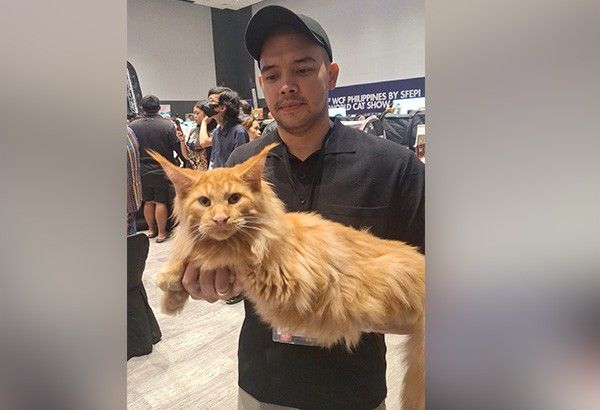How to take care of strays: Cat owner shares tips

MANILA, Philippines — Cat lover Clint Brian Peck currently takes care of 25 Maine Coons, a breed of large domesticated cats.
His love for the furry creatures started when he was a young boy, when he started picking up strays from the streets.
His years of saving them has led him to realize that apart from just finding them cute, there is a set of responsibilities that a potential cat parent should know about before they consider adopting a cat into their homes.
"It's a commitment talaga. It's not just picking it up because it's cute, then eventually I cannot take care of this. 'Yun 'yung mahirap e, which is 'yun 'yung nakikita ko palagi," he said to Philstar.com at the recent 1st World Cat Federation Show held in Makati from June 14 to 15.
The show was co-presented by the Society of Feline Enthusiasts of the Philippines Inc. (SFEPI) and Hard Rock Cafe Manila. Peck is associated with both as he is the director for operations at Hard Rock Cafe Manila and he is on the board of SFEPI.
Quarantine
Just like in any animal, the cat's wellbeing is of utmost importance.
"First of all, you have to consider also 'yung location. Hindi 'yung pulot tayo basta-basta and then ilalagay natin kung meron tayong ibang animals (sa bahay)," he stressed.
Peck said that the first thing one must consider is to quarantine the cat, which usually takes 10 to 14 days. These days will determine if the cat has any virus.
"If walang lumabas na any virus, it doesn't mean it's clear. That's the time na kapag walang lumabas na any symptoms, walang sipon, walang ubo, you will jump to another procedure, which is blood test. Pero pwede mo naman gawin 'yung blood test during the quarantine para at least alam mong negative siya," he advised.
Testing for viruses
Peck listed the tests that cats should undergo. Cats are susceptible to viruses and illnesses. Among these is the Feline Infectious Peritonitis, which the MSD Veterinary Manual describes as a "severe, immune-mediated coronaviral disease of cats." It is caused by certain strains of the Feline Coronavirus (FCoV).
The others are FelV or Feline Leukemia Virus, Calicivirus (oral and respiratory infection) and Panleukopenia (feline distemper).
"These are fatal viruses and these are highly contagious among the cats but, not canine. They are not transferrable to humans. 'Pag clear na sa mga virus na 'yun, that's the time that you can mingle them to other cats," he said.
Other cat infections such as ear mites and fleas are treatable. Cats also need internal and external deworming. Internal deworming rids the cats of worms in its intestines, while external deworming kills fleas and tick.
Vaccinations
After the cat has been cleared of these viruses, they need their vaccinations for their own protection as well as for their human parents.
"Depende 'yan sa age but usually one shot muna then after 21 days, proceed with another shot, then rabies," Peck said.
It is important to consult a veterinarian so they would prescribe the vaccinations the cat needs. They may also be able to diagnose other diseases the cat may have that could be addressed and treated, if possible, as early as possible.
Peck underscored one vaccine that is a must.
"Rabies is very deadly, fatal when you get accidentally bitten by an animal with rabies. Make sure about naba-vaccinate 'yung animals every year," he said.
Spaying or neutering
Peck said that castration is part of their group's advocacy, given the growing population of cats. Neutering the cat is often seen a responsible decision as it helps address the overpopulation issue among cats, especially strays.
Accordingly, cats give birth three to four times every year, which is an average of every three months. They give birth to an average of three to five kittens per delivery.
Comfortable environment
The cat owner said that part of properly addressing the cat's need is knowing its behavior, because every cat behaves differently.
"Different cats kasi have different behaviors. It's like if you have different children, but at the end of the day, they're all charming," he noted.
He also underscored the need for the cat to be comfortable in its environment.
"At least comfortable ang cat kasi ang cat mabilis ma-stress e. 'Pag hindi comfortable 'yung cat, it will add to the stress and changes to the adjustment nila sa environment. So, there should be a clean water, food, clean litter box," he said.
As an advice, Peck said one must be a responsible cat owner who is after his fur baby's health and well-being.
"Having a pet is a very long commitment. Hindi 'yung after two years, ayaw mo na, 'di ba? It's a commitment. It's like a relationship e, and the pet is depending on you for the grooming, the care, the food, the environment. Those are very important," he said.
Whether the cat is a welcome addition from the streets or one that comes from shelters or rescue organizations, it is important to take note of these factors to consider for those who want to be responsible cat parents.
RELATED: Philippines' 1st World Cat Show set this weekend in Makati


















